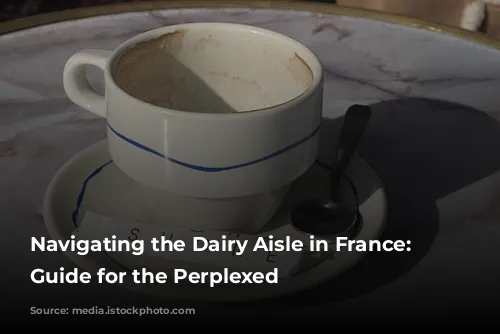Are you ready to tackle the dairy section of a French supermarket? It’s a wonderland of choices, but it can also be a bit overwhelming if you’re not familiar with the local lingo. Fear not! This guide will help you decipher the labels and find the perfect dairy products for your needs.
Milk: From Fresh to Shelf-Stable
The French are big fans of shelf-stable milk. You’ll find it both in the refrigerated section, nestled among the butter, cheese, and yogurt, and on the shelves near the water. These milk cartons, often made of cardboard or plastic, are convenient for keeping a supply on hand. While some people prefer the taste of fresh milk, shelf-stable milk is a lifesaver for those who don’t drink a lot or need milk on the go.
There’s a whole world of milk varieties available:
-
Lait frais: This is your classic, fresh pasteurized milk. It comes in two main varieties: Demi-écrémé (typically with a blue cap), which means half the cream of regular whole milk (about 2% fat), and écrémé, which is skim milk (labelled as Bridelight or simply lait écrémé).
-
Buttermilk can be found under various labels: lait fermenté, lait ribot, or lait caillé.
-
Soy milk (lait de soya) and soy yogurt are readily available in health food stores and the organic sections of many supermarkets.
Mastering the Creams: More Than Just Whipping
The world of cream can be a little tricky to navigate. But don’t worry, we’ll break it down for you:
-
Crème fraîche: A staple in French kitchens, crème fraîche is thicker than American sour cream and a bit less sour. It’s a fantastic substitute in many recipes. You can find it in a range of fat content, from super rich (around 40%) to light (3%). Look for “matière grasse” (or m.g. or mat. gras) followed by a percentage to determine the fat content. Any cream marked “épaisse” will have the consistency of sour cream.
-
Other creams: You’ll encounter creams like crème fraîche fluide, crème entière liquide, crème fouettée, or crème chantilly. Remember, a cream must have at least 30% fat to whip. Lower fat creams are delicious in sauces, baking, and desserts, but won’t whip up. Creams are available in both refrigerated and shelf-stable varieties.

Yogurt: A Universe of Options
Yogurt lovers, rejoice! The selection in French supermarkets is incredible. Here’s a quick guide to help you navigate the labels:
-
Fat content: Remember, m.g. indicates the fat content. If it’s not clearly stated, it’s likely a full fat yogurt. For reduced fat options, consider the Taillefine brand by Danone, which also has no added sugar.
-
Other types of yogurt: Yogurt made from goat’s milk (lait du chevre) and sheep’s milk (lait du brebis) are widely available. Yaourt brassé is a yogurt with a very smooth texture.

Beyond Yogurt: Fromages Frais and More
Don’t be fooled by the packaging: not everything labelled like yogurt is actually yogurt. Perle de Lait is a dessert made with fromage frais and has a 9% fat content. Le Petit Suisse by Gervais, a sweetened fromage frais, is a favorite among children.
Fromage blanc and fromage frais have no direct equivalent in North America. They are smooth, thicker than yogurt, and often served as a dessert with fruit, honey, or sugar. You can find them in various fat contents and sizes, from individual portions to family-sized tubs.
Faisselle is a thicker, richer type of fromage frais, sometimes compared to cottage cheese, but without the chunks.

Exploring the Fromage World
For an even wider selection of dairy products, head to your local fromagerie or visit the fromager at your neighborhood open-air market. You can buy small portions of yogurt, perfect for trying different flavors and textures.

Cheese: A World of Flavors
We won’t delve into the vast world of French cheeses here, as there are literally hundreds of varieties, and the best ones are usually found outside of supermarkets. However, if you have picky eaters, you’ll be happy to know that you can find Kraft singles (labelled as burger cheese). You’ll also find supermarket versions of emmental and comte, mild cheeses similar to Swiss, that might appeal to kids. Cheddar is difficult to find and expensive, so some use mimolette as a substitute due to its orange color, although it doesn’t taste the same.








